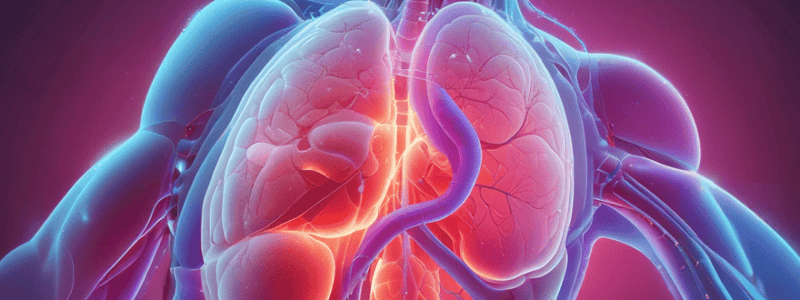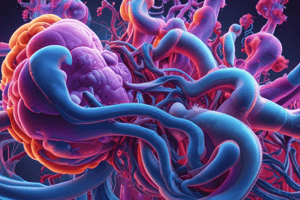Podcast
Questions and Answers
What is the volume of oxygen in ml present in chemical combination with Hb in 100ml blood when fully saturated?
What is the volume of oxygen in ml present in chemical combination with Hb in 100ml blood when fully saturated?
- 10 ml
- 30 ml
- 25 ml (correct)
- 15 ml
Which factor determines the rate and direction of oxygen diffusion in the blood?
Which factor determines the rate and direction of oxygen diffusion in the blood?
- Carbon dioxide content
- Oxygen tension (correct)
- Oxygen content
- Diffusion coefficient
What is the nature of oxygen when it combines with iron (Fe+2) of hemoglobin?
What is the nature of oxygen when it combines with iron (Fe+2) of hemoglobin?
- HbO2 (correct)
- HbO4
- HbO8
- HbO6
Which form of oxygen constitutes about 2% in blood?
Which form of oxygen constitutes about 2% in blood?
What determines the percentage of hemoglobin saturation?
What determines the percentage of hemoglobin saturation?
What is the volume of oxygen in ml present in 100ml arterial blood with a PO2 of 100mmHg?
What is the volume of oxygen in ml present in 100ml arterial blood with a PO2 of 100mmHg?
Which compound determines the O2 capacity and O2 content present in blood?
Which compound determines the O2 capacity and O2 content present in blood?
What is the shape of the myoglobin dissociation curve?
What is the shape of the myoglobin dissociation curve?
At what pO2 level is myoglobin fully saturated with oxygen during rest?
At what pO2 level is myoglobin fully saturated with oxygen during rest?
What is the role of myoglobin in skeletal muscle?
What is the role of myoglobin in skeletal muscle?
What happens to myoglobin's oxygen during muscle exercise?
What happens to myoglobin's oxygen during muscle exercise?
In which form does myoglobin combine with oxygen?
In which form does myoglobin combine with oxygen?
What happens to the p50 value in a left shift of the oxygen dissociation curve?
What happens to the p50 value in a left shift of the oxygen dissociation curve?
What tests should be ordered to calculate a patient's blood oxygen concentration?
What tests should be ordered to calculate a patient's blood oxygen concentration?
What kind of pigment is myoglobin?
What kind of pigment is myoglobin?
At what tissue level does myoglobin give its oxygen to the muscles?
At what tissue level does myoglobin give its oxygen to the muscles?
At which partial pressure of oxygen (PO2) does hemoglobin (Hb) become 90% saturated with oxygen?
At which partial pressure of oxygen (PO2) does hemoglobin (Hb) become 90% saturated with oxygen?
What is the oxygen content of arterial blood at a $PO_2$ of 100 mmHg?
What is the oxygen content of arterial blood at a $PO_2$ of 100 mmHg?
What is the percentage of hemoglobin saturation with oxygen in venous blood at a $PO_2$ of 40 mmHg?
What is the percentage of hemoglobin saturation with oxygen in venous blood at a $PO_2$ of 40 mmHg?
Which part of the oxygen-hemoglobin dissociation curve represents the release of oxygen to tissues?
Which part of the oxygen-hemoglobin dissociation curve represents the release of oxygen to tissues?
What is the significance of the sigmoid shape of the oxygen-hemoglobin dissociation curve?
What is the significance of the sigmoid shape of the oxygen-hemoglobin dissociation curve?
At high altitudes, what is the approximate partial pressure of oxygen (PO2) in the lungs?
At high altitudes, what is the approximate partial pressure of oxygen (PO2) in the lungs?
What is the oxygen capacity of hemoglobin?
What is the oxygen capacity of hemoglobin?
What is the primary function of the steep portion of the oxygen-hemoglobin dissociation curve?
What is the primary function of the steep portion of the oxygen-hemoglobin dissociation curve?
What is the significance of the p50 value in the oxygen-hemoglobin dissociation curve?
What is the significance of the p50 value in the oxygen-hemoglobin dissociation curve?
Which of the following factors causes a right shift in the oxygen-hemoglobin dissociation curve, decreasing the affinity of hemoglobin for oxygen?
Which of the following factors causes a right shift in the oxygen-hemoglobin dissociation curve, decreasing the affinity of hemoglobin for oxygen?
What is the effect of a left shift in the oxygen-hemoglobin dissociation curve?
What is the effect of a left shift in the oxygen-hemoglobin dissociation curve?
Which form of hemoglobin has a higher affinity for oxygen?
Which form of hemoglobin has a higher affinity for oxygen?
What is the effect of carbon monoxide poisoning on the oxygen-hemoglobin dissociation curve?
What is the effect of carbon monoxide poisoning on the oxygen-hemoglobin dissociation curve?
Which of the following statements is true about the shape of the oxygen-hemoglobin dissociation curve?
Which of the following statements is true about the shape of the oxygen-hemoglobin dissociation curve?
Flashcards are hidden until you start studying




